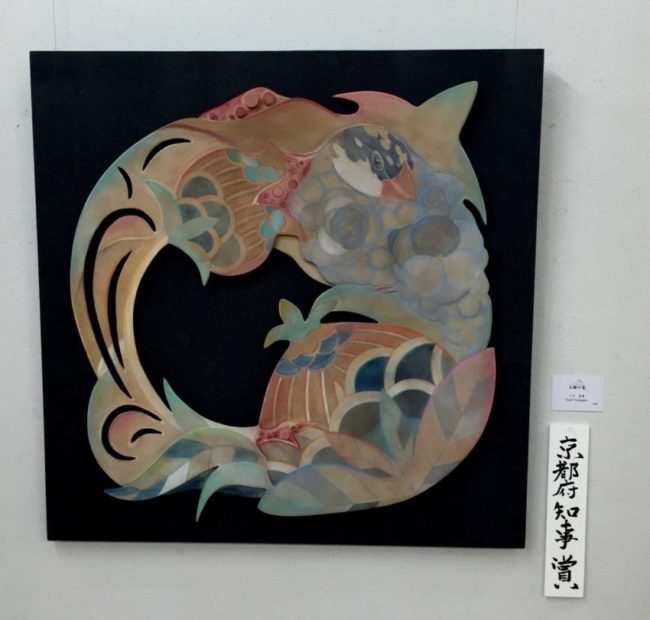Paintings and Drawings at the 30th Kyoto Art Festival: International Exhibition of Art 2016

The lines are blurred between the different styles of painting and their labels. In Japan, the traditional method of mixing powdered pigments (often made from natural minerals) with binders is called nihonga to differentiate from paintings done with oil or acrylic paints to create a gouache effect. Coloured pencils are basically dried oil paint or watercolour paint in a stick. What if you used stencils with dyes on paper? Things get complicated as you can see.
Guri Tomosato has been pushing herself to try new things every year. She has started mixing a manga-influenced style with traditional nihonga painting methods. As you can see, Guri won the Kyoto Prefecture Governor’s prize. Congratulations!
Michelle Zacharias, a Canadian artist living in Japan, showed the affects of pollution from the yellow dust that blows from Central Asia in Imari Winds. Why Imari? The patterns on an Imari-yaki ceramic platter were inspiration.
Sayaka Kanda prefers grey tones in her nihonga paintings. The horse was not quite life-sized, but it was close.
Haruka Iwai also prefers muted tones in her nihonga paintings but usually does abstracts that seem organic.
Ichiha called this nihonga painting 時々雨 (Toki Doki Ame) or Sometimes Rain in English.
Kenta Ohnishi usually uses pastel colours and lots of white in his nihonga paintings, but Ohnishi used brighter colours this year.
Masayuki Isa‘s paintings are crossing genres. His family runs a studio that stencils or dyes fabric in traditional patterns and methods, but he also uses stencils and dyes on handmade paper (washi) to create modern paintings.
You can see Isa and hear him speak in English between 5:10-5:16 in the video.
Yuko Hirata is a nihonga painter who likes to play with light and darkness with natural themes. She was also in the show at Kokoka last year featuring seven artists.
Kyoko Manabe is another nihonga painter that uses organic or natural themes but then makes them slightly abstract.
Chikako Kamide is another nihonga painter who uses nature as her main theme. She also submitted a similar painting to Nitten in 2016 and won a prize for it.
KellyAnne Hanrahan, an American artist, prefers oil paint. Here in Playing and in other paintings, she shows humans as wildlife in their natural settings with dark humour.
Haruo Suzuki is one of the organizers and a Kyoto resident. Land is very detailed and much smaller than you would expect.
Nao Morigo has exhibited all over the world but this was her first time in the show at the Annex.
Katya Swafford-Cho, an American artist and Kyoto resident, has a unique, vibrant style. Family was made with one of her favorite mediums, watercolour paint.
Tserennadmid Tsegmed, a Mongolian artist, exhibited for the first time at the Annex. If I recall correctly, his work was also shown at the Fukuoka Asian Art Museum in the past.
Luanda Lozano, born in Angola but resides in the United States, used mixed media for this landscape.
Michal Poleg, an Israeli artist, painted a series of dolls and called it, Longings for Innocence Beyond Time. Each painting is quite small.
Charles Roche, an American artist residing in Kyoto, also prefers natural subjects for his paintings.
Makiko Berry, a Japanese artist and Kyoto resident, is another nihonga painter. Her paintings usually use blue tones in her distinctive style.
Makiko Arai, one of the organizers and supervisor on the Kyoto Art Festival committee, prefers oil paint and landscape scenes around Kyoto, such as this scene in 朝陽 (Asahi) or Morning Sun.
Naho Futagami is a nihonga painter who prefers bright abstracts.
As you can see, the annual show at the Annex has a lot of variety. The artists themselves arrive every year curious to see what the others have created.



























Leave a Reply